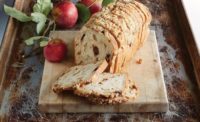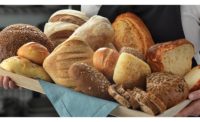
Loaves of Art
By Deborah Cassell
Bakers are upgrading bread baskets, in-store offerings and even fast food menus with Old World-style, artisan creations that bring flavorful variety to everything from dinner rolls to take-home loaves.
Onion Ciabatta. Rosemary Olive Oil Focaccia. Roasted Garlic Baguettes. When consumers go grocery shopping or out for dinner, these are the breads they expect from in-store bakeries and upscale restaurants alike. For many consumers, it’s hard to imagine a meal without today’s crusty artisan offerings. Some might say it’s almost impossible to remember what life before ciabatta was like.
Then again, some folks have short memories.
The growing popularity of the artisan bread segment is at least partly due to the success of The Food Network, according to John Yamin, CEO of La Brea Bakery, Van Nuys, Calif.
As a result of consumer interest in what celebrity chefs are doing on cooking shows 24/7, “People are becoming more comfortable in the kitchen,” he says. Today, good food, upscale cooking, gourmet ingredients and premium indulgence are all very much a part of our lifestyle and day-to-day living, Yamin explains.
“We know we can’t control the world or necessarily what happens during the course of the day, but we can control supper with the family,” he says.
Yes, a little taste of the Old World can provide a moment of comfort in our stressful modern lives.
“Serving and consuming great, not just good, bread is a luxury that people want and need in their busy, out-of-control lives,” Yamin continues.
Among consumers, La Brea has made a name for itself as a leading artisan bread brand. Its core “archetypical” offerings, Yamin says, are Organic Wheat Loaf, Italian Round, Italian Round, Tuscan Loaf, Roasted Garlic Loaf, Pain Rustique, French Loaf, Country White Sourdough Oval, French Baguette, Whole Grain Loaf and Rosemary Olive Oil Round. The brand’s now two-year-old Three-Cheese Semolina Loaf also has grown into one of the brand’s top three sellers, he adds.
At retail, Yamin notes, the usual top three varieties are baguettes, rounds and loaves, while in-store bakery/delis rely on rolls such as La Brea’s Demi Baguettes.
In-store bakeries offer the truest form of artisan bread, with just a couple days of shelf life, according to John Anthony Orlando, vice president of Orlando Baking Co., another major player in this segment. The Cleveland, Ohio-based specialty baker is perhaps best known for its signature ciabatta bread.
“Ciabatta bread remains our most popular item,” Orlando asserts. Compared to five years ago, he adds, this particular variety is becoming more mainstream and accepted by the general public.
Square ciabatta rolls also are the leading artisan product for Highland Baking of Northbrook, Ill., according to vice president Stu Rosen, who adds that ciabatta pan bread and Sauteed Onion Ciabatta are among the company’s most unique offerings.
One need look no further than quick-service restaurants such as Jack-in-the-Box — which now offers a Sirloin Steak n’ Cheddar Ciabatta Steak Sandwich, a Bacon n’ Cheese Ciabatta Burger and a Bruschetta Chicken Ciabatta Sandwich — for evidence that artisan bread is as at home in bread baskets as it is on fast food menus.
Wendy’s line of Frescata sandwiches also reflects the far-reaching impact of this trend. The chain’s Chunky Chicken Salad, Club, Roasted Turkey & Swiss and Black Forest & Swiss offerings are served up on Wendy’s “freshly baked artisan bread.”
As Yamin says, “In the world of sandwiches, whereas meat, cheese and sauce used to reign supreme, today the emphasis in on the bread.”
The fact that quick-service restaurants are exposing everyday consumers to artisan breads “is a great thing for bakers like us,” says Orlando, because it educates the public and introduces people to different ways to use the breads. “We are receiving more requests for sandwich-size artisan breads in many different flavors — wheat and multigrain being the most popular.”
Rich Labriola, CEO of Labriola Baking Co, Alsip, Ill., observes that the upscale breads being offered by fast food places are far from real ciabatta or foccaccia. However, he adds, “They are huge improvements over the standard industrial hamburger buns. ... As long as people don’t start thinking that it is real artisan bread, artisan bakers can relax.”
Overall, Yamin also is pleased with what fast food purveyors are doing.
“We applaud QSR establishments such as Wendy’s that are succeeding in offering their customers convenience, affordable prices, health and wellness, and high-quality products,” he says. “Artisan bread then becomes integrated into consumers’ lifestyle. We love it!”
The Basket Case
Although artisan bread has gone mainstream in fast food entities and sandwich shops, its true calling may be as a premium bread basket selection at sit-down restaurants. Dinner and sandwich rolls, as well as baguettes, batards, extra-large loaves and ciabatta or flatbreads, are among the top sellers in this channel, Yamin says.
Artisan breads lend flexibility to bread baskets, offering an opportunity to provide authentic sour doughs or other heavily crusted bread, according to Labriola.
As Yamin adds, the bread basket is “the first impression of the meal. It not only enhances the meal, it also enhances the consumer’s overall experience at the establishment.”
Because La Brea believes so much in the power of the bread basket, next year it plans to launch a branded bread basket program for its foodservice customers, who recognize the benefits of giving consumers high-end, premium breads.
“We encourage any situation that elevates customers’ bread tastes and expectations,” Yamin assserts.
Grain Goodness
Artisan isn’t the only bread trend elevating customers’ tastes. Enter whole grains.
“Whole grains are increasingly becoming more important to consumers,” Yamin says. For this reason, La Brea has a line of Whole Grain Goodness products, including a Whole Wheat & Honey Loaf and a Whole Grain Baguette, containing 34 g. and 41 g. of whole grains per serving, respectively. The company also produces a Whole Grain Pocket Guide containing frequently asked questions for bakery personnel so that they can convey accurate facts to the end consumer.
However, mainstream acceptance of whole grain artisan bread products does face a challenge.
According to Labriola, “The problem is that new whole grain customers will fall by the wayside if bakeries don’t come up with whole grain breads that taste good without loading them up with sugar. This is not impossible, but it takes some steps to ferment the whole wheat or rye over time to bring out the flavor of the wheat.”
Orlando agrees that demand for whole grains is increasing among artisan bread shoppers. But “overall, I feel that these shoppers are looking for good quality artisan breads in all flavors,” he says.
Clean, Natural, Organic
The all-natural and organic movements also are impacting the artisan bread segment.
All of La Brea’s products are free from preservatives and artificial flavors or colors, making them very “clean,” but not necessarily organic. That said, the bakery does offer three certified organic breads — Organic Wheat Loaf, Organic French Baguette and Organic Rustic French Loaf — that also are “all-natural,” a term that seems to resonate with consumers even more these days.
In addition, Labriola is working on an organic bread project for one customer. As the CEO or “chief dough boy” says, “Organic is and will continue to be a fast-growing segment for years to come.”
Orlando notes that organic breads are a smaller base, so as a portion of all upscale breads, the growth might not be as dramatic in the grand scheme.
“I think some people will always purchase a product because it is organic, but the majority will purchase the product because it is good, organic or not,” he says
Fad or Timeless Trend?
Although artisan breads — as well as whole grains and organic — currently are all the rage, what are the odds that this trend will crash the way low-carb did? Slim to none, according to many bakers. After all, Europeans have been eating the artisan way for years.
However, as Rosen suggests, “Artisan is here to stay, but maybe not to the degree it is right now.”
Regardless, Orlando says, artisan breads “are better breads.” He adds that the future of the segment will continue to grow as consumers become more educated.
Yamin stresses that the “art” of baking is what differentiates artisan bread from other commercial breads.
“Artisan bread should reflect the person or persons whom actually made the bread. ... You know it’s good artisan bread if you can immediately see and taste the inherent beauty of the bread based on the way it’s made,” he notes.
But interest in artisan goes beyond mere bread, Labriola says.
“Artisan bread’s popularity is just part of a great food movement,” he suggests. “Everyone wants better-tasting, more natural foods. The word ‘processed’ is fast becoming a no-no in the food industry. Bread is actually one of the least expensive ways to increase your quality food intake. I am proud to say that our bread will go stale in a couple days, not a couple of weeks. Staling is natural process, unless you pump it full of additives. If you can spell flour, water, yeast and salt, then you know what is in the most authentic artisan breads.”
That’s something everyone can remember. SF&WB
Art in the Aisles
Although consumers often look to in-store bakeries and displays for crusty artisan loaves, the good ol’ bread aisle is another source of Old World-style satiety. For example, shoppers can turn to Pepperidge Farm’s line of par-baked, preservative-free, Hearth Fired Artisan Bread in four varieties: Sourdough Petite Loaves, Rosemary Olive Oil Petite Loaves, French Demi-Baguettes and Hearty Wheat Rolls. Art ... it’s everywhere!
Bread Cheer
Holidays breads are big business for at least one artisan baker.
Every season, La Brea Bakery, Van Nuys, Calif., introduces a limited-edition bread under its Season’s Signature line. This year, the La Brea brand offered an Apple Raisin Spice Loaf for fall and a Fruit & Nut Loaf for winter. Next spring it will launch a Roasted Garlic and Sweet Scallion bread, followed by a Toasted Almond & Sweet Cherry for summer.
In addition, La Brea offers a Chocolate Sour Cheer Round that’s perfect for special occasions.
“We bring it back every year because people can’t live without it,” says CEO John Yamin.


